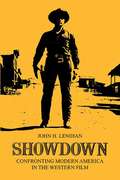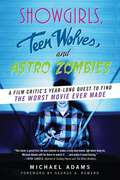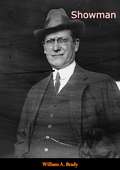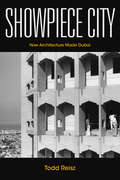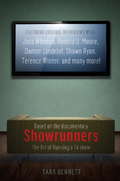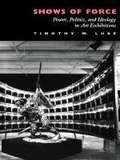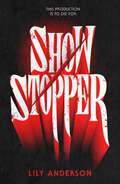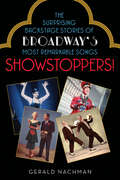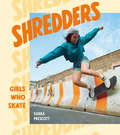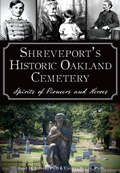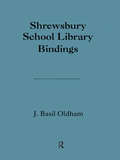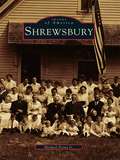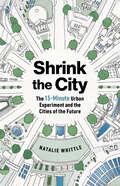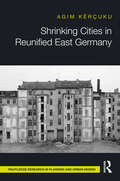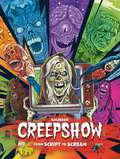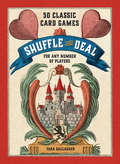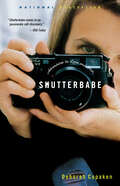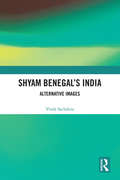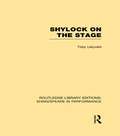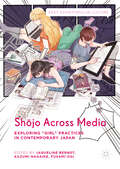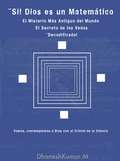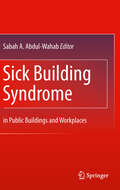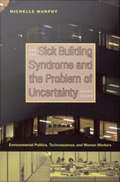- Table View
- List View
Showdown: Confronting Modern America in the Western Film
by John H. LenihanThe author examines modern American culture through the lens of the Hollywood western.
Showgirls, Teen Wolves, and Astro Zombies: A Film Critic's Year-Long Quest to Find the Worst Movie Ever Made
by Michael Adams"Michael Adams's book is great fun! No one intends to make a truly bad movie, but when they do, Michael Adams will be there to watch it...and make it entertaining!" —John Landis, director of Trading Places and The Blues Brothers In Showgirls, Teen Wolves, and Astro Zombies, film critic Michael Adams embarks on a year-long odyssey to discover the worst movie ever made, which Mystery Science Theater 3000 star, writer, and director Kevin Murphy calls "disturbingly comprehensive, joyously critical, and the best of its kind." From all-time cult classics such as Reefer Madness and Plan 9 from Outer Space to new entries to the pantheon such as Gigli and Baby Geniuses, no genre, star, or director is safe from Adams’s acerbic wit and hilarious observations. In the vein of A.J. Jacobs’s New York Times bestselling book The Know-It-All, and with the snarky sarcasm of television’s Mystery Science Theater 3000 and The Soup, Showgirls, Teen Wolves, and Astro Zombies leaves no stone unturned. With a foreword by cult director George A. Romero (Night of the Living Dead and Dawn of the Dead).
Showing Time: In Memory of Alberto Argenton
by Ian F. Verstegen Laura Messina-Argenton Tiziano Agostini Tamara PrestHow does a visual artist manage to narrate a story, which has a sequential and therefore temporal progression, using a static medium consisting solely of spatial sign elements and, what is more, in a single image? This is the question on which this work is based, posed by its designer, Alberto Argenton, to whose memory it is dedicated. The first explanation usually given by scholars in the field is that the artist solves the problem by depicting the same character in a number of scenes, thus giving indirect evidence of events taking place at different times. This book shows that artists, in addition to the repetition of characters, devise other spatial perceptual-representational strategies for organising the episodes that constitute a story and, therefore, showing time. Resorting to the psychology of art of a Gestalt matrix, the book offers ha formattato: Italiano (Italia) Codice campo modificato ha formattato: Italiano (Italia) ha formattato: Italiano (Italia) researchers, graduates, advanced undergraduates, and professionals a description of a large continuous pictorial narrative repertoire (1000 works) and an in-depth analysis of the perceptual-representational strategies employed by artists from the 6th to the 17th century in a group of 100 works narrating the story of Adam and Eve.
Showman
by William A. BradyReminiscence of American actor, manager, stage and motion-picture producer, and sports promoter, William A. Brady.“Well named, this autobiography of a representative “showman” of the jovial ‘90’s, and though it is primarily a rapid fire account of a many-sided career, you get the man himself, jovial, generous, mad Irish, rough diamond, naively and somewhat crudely presented. From the Bowery to Broadway via journalism, peanut vender, butcher, years in stock, playing through Mid-Western towns Hamlet and The Streets of New York alternately, spellbound by melodrama, persuaded into promoting prize fights in nationwide arenas, living high and low, taking wild chances, actor, manager, producer, Jack of all Trades and Master Showman of each.”—Kirkus Reviews
Showpiece City: How Architecture Made Dubai (Stanford Studies in Middle Eastern and Islamic Societies and Cultures)
by Todd ReiszStaggering skylines and boastful architecture make Dubai famous—this book traces them back to a twentieth-century plan for survival. In 1959, experts agreed that if Dubai was to become something more than an unruly port, a plan was needed. Specifically, a town plan was prescribed to fortify the city from obscurity and disorder. With the proverbial handshake, Dubai's ruler hired British architect John Harris to design Dubai's strategy for capturing the world's attention—and then its investments. Showpiece City recounts the story of how Harris and other hired professionals planned Dubai's spectacular transformation through the 1970s. Drawing on exclusive interviews, private archives, dog-eared photographs, and previously overlooked government documents, Todd Reisz reveals the braggadocio and persistence that sold Dubai as a profitable business plan. Architecture made that plan something to behold. Reisz highlights initial architectural achievements—including the city's first hospital, national bank, and skyscraper—designed as showpieces to proclaim Dubai's place on the world stage. Reisz explores the overlooked history of a skyline that did not simply rise from the sands. In the city's earliest modern architecture, he finds the foundations of an urban survival strategy of debt-wielding brinkmanship and constant pitch making. Dubai became a testing ground for the global city—and prefigured how urbanization now happens everywhere.
Showrunners: The Art of Running a TV Show
by Tara BennettCollected from a truly expansive exploration of television's most creative minds, Showrunners is an insider's guide to creating and maintaining a hit show in today's golden age of television. The official companion to the documentary Showrunners, this highly informative book features exclusive interviews with such acclaimed and popular showrunners as Joss Whedon, Damon Lindelof, Ronald D.Moore, Terence Winter, Bill Prady, Shawn Ryan, David Shore, and Jane Espenson.
Shows of Force: Power, Politics, and Ideology in Art Exhibitions
by Timothy W. LukeIt has long been considered a mark of naïveté to ask of a work of art: What does it say? But as Timothy W. Luke demonstrates in Shows of Force, artwork is capable of saying plenty, and much of the message resides in the way it is exhibited. By critically examining the exhibition of art in contemporary American museums, Luke identifies how art showings are elaborate works of theater that reveal underlying political, social, and economic agendas.The first section, "Envisioning a Past, Imagining the West," looks at art exhibitions devoted to artworks about or from the American West. Luke shows how these exhibitions--displaying nineteenth- and early-twentieth century works by artists such as George Caleb Bingham, Frederic Remington, Frederic Edwin Church, and Georgia O'Keefe--express contemporary political agendas in the way the portray "the past" and shape new visions of "the West."In "Developing the Present, Defining a World," Luke considers artists from the post-1945 era, including Ilya Kabokov, Hans Haacke, Sue Coe, Roger Brown, and Robert Longo. Recent art exhibits, his analysis reveals, attempt to develop politically charged conceptions of the present, which in turn struggle to define the changing contemporary world and art's various roles within it.Luke brings to light the contradictions encoded in the exhibition of art and, in doing so, illuminates the political realities and cultural ideologies of the present. Shows of Force offers a timely and surely controversial contribution to current discussions of the politics of exhibiting art.
Showstopper
by Lily Anderson"A witty summer camp murder mystery where drama unfolds both on and off the stage . . . . In this love letter to theater life, the joy and passion derived from the art form shine through brightly." —Kirkus ReviewsTAKE YOUR FINAL BOWThe Ghostlight Youth Theater Camp isn’t the best program in the world, but to Faye, it’s home. Every summer since junior high, Faye and her friends have come together for a monthlong musical-theater intensive. For her last year before graduation, Faye’s finally ready to take center stage as her true Afro-Latina self and break out of her white-passing roles.But as Faye steps into her spotlight, complications arise. Suddenly, she’s competing with her BFF for lead roles and distracted by the attentions of the new camp hottie. Even when the drama turns deadly, Faye remains determined to make this the best production the Ghostlight has ever seen. It must be a coincidence that the stagehands keep disappearing and having gruesome accidents, right? But dark secrets are hiding behind the scenes, and opening night might turn out to be a bloodbath.
Showstoppers!: The Surprising Backstage Stories of Broadway's Most Remarkable Songs
by Gerald NachmanWhen Robert Preston shouted "Ya got trouble!" in River City, when Carol Channing glided down a gilded staircase while waiters serenaded her with "Hello, Dolly!," when Barbra Streisand defied us to rain on her parade in Funny Girl, audiences were instantly enchanted. Showstoppers! is all about Broadway musicals' most memorable numbers--why they were so effective, how they were created, and why they still resonate. Much of it is told through the eyes of the performers, songwriters, directors, and choreographers who first built these explosive numbers and lit the fuse. Gerald Nachman interviewed dozens of iconic musical theater figures, including Patti LuPone, John Raitt, Jerry Herman, Edie Adams, Dick Van Dyke, Joel Grey, Marvin Hamlisch, John Kander, Tommy Tune, Sheldon Harnick, and Harold Prince, uncovering priceless untold anecdotes and details.
Shredders: Girls Who Skate
by Sierra PrescottA stunningly photographed tribute to female skaters of all ages and backgrounds, from novice to pro--plus an illustrated history of the skateboard, skating tips and tricks, and more.In celebration of the rad, undying spirit of skateboarding, Shredders features gorgeous photography and stories of today's most awesome female skaters. The women and girls profiled range from rising young riders like eight-year-old Ariel Cai--who shreds at the largest indoor skate park in China--to old-school pros like Laura Thornhill Caswell--the first woman to get a signature model board--and today's star shredders like X Games gold winner and Tony Hawk protégé Lizzie Armanto. From street and slalom skaters to park queens and long-distance pushers, Shredders features athletes and hobbyists of all skate styles, ages, backgrounds, and skill levels, showing that skateboarding has something for everyone.For aspiring skaters, Shredders is the perfect entryway into the world of skateboarding, with tips for setting up and maintaining your board as well as overviews of skate styles, history, and slang. And Shredders also invites experienced riders to fall back in love with the sport that embodies freedom, individuality, and active self-expression. Skaters of every stripe are sure to find their inspiration to shred within these pages.
Shreveport's Historic Oakland Cemetery: Spirits of Pioneers and Heroes (Landmarks)
by Gary D. Joiner Cheryl WhiteNearly as old as the city itself, Oakland Cemetery is one of Shreveport's most significant historical landmarks. Notable residents were laid to rest here as early as 1842. In a mass grave lie nearly eight hundred victims of a virulent yellow fever epidemic that struck the city in 1873. Others interred include Annie McCune, the famous Shreveport madam who operated a brothel in the city's red-light district, as well as hundreds of Civil War soldiers, city founders and the first African American physician, Dr. Dickerson Alphonse Smith. Some souls are said to haunt the grounds still. Join authors Gary D. Joiner and Cheryl White and discover some of Shreveport's oldest stories.
Shrewsbury School Library
by James B. OldhamFirst Published in 1990. Shrewsbury School dates back to the end o f the sixteenth century, and owes its existence to the provision contained in the Ordinances of 1578. This is a listing and descriptions of the books, bindings and comtents of the library.
Shrewsbury: America Through Time (Images of America)
by Michael Perna Jr.Discover the history of Shrewsbury, Massachusetts. Incorporated in 1727, this once small farming town has transformed itself into a successful business and residential community. Meet the "Father of the Stages," nicknamed for his stagecoach line, and the many other inventive citizens of Shrewsbury. Experience the fun of the White City Amusement Park. From the days of Maj. Gen. Artemas Ward, the first commander in chief of the Revolutionary army, to the social days around Lake Quinsigamond, Shrewsbury takes you through these dramatic changes. Using exciting vintage photographs and postcards, Shrewsbury provides the first comprehensive photographic account of how the town once looked. Readers will learn about Balance Rock, the old town hall, and one-room schoolhouses. They will see stately mansions, the many attractions Lake Quinsigamond once had, and parts of the town that exist only in memory, such as South Shrewsbury and the Lower Village. Shrewsbury will allow all the town's citizens, past and present, to see and enjoy its history firsthand.
Shrink the City: The 15-Minute Urban Experiment and the Cities of the Future
by Natalie Whittle“[Shrink the City] surveys ways in which cities around the globe have created compact neighborhoods where residents’ daily needs are quickly accessible on foot or by bicycle—a concept known as the 15-minute city. . . . deeply researched and winsomely written. . . an invaluable overview of the cutting edge of urban planning.”—Publishers Weekly Cities define the lives of all those who call them home: where we go, how we get there, how we spend our time. But what if we rethink the ways we plan, live in, and move around our cities? What if we didn’t need a car to reach the grocery store? What if we could get back the time we would have spent commuting and put it to other uses? In this fascinating, carefully researched and reported book, longtime Financial Times journalist Natalie Whittle investigates the 15-minute city idea—its pros, cons, and its potential to revolutionize modern living. From Paris, Melbourne, and Rotterdam to Charlotte, North Carolina, and Tempe, Arizona, cities worldwide are being guided by the 15-minute city’s ideals—with varying results. By looking at these examples, Whittle considers: what really happens when a city expands bike lanes and pedestrian areas—and disincentivizes long commutes which approaches to building affordable housing are actually effective how neighborhoods of varying wealth are affected by 15-minute city policies whether it’s possible to convince car-owning city dwellers to replace their vehicles with other forms of transport. This timely book serves as a call to reflect on our cities and neighborhoods—and it outfits us with insights on how to make them more sustainable, safe, and welcoming.
Shrinking Cities in Reunified East Germany
by Agim KërçukuThe book explores the relationship between the shrinking process and architecture and urban design practices. Starting from a journey in former East Germany, six different scenes are explored in which plans, projects, and policies have dealt with shrinkage since the 1990s. The book is a sequence of scenes that reveals the main characteristics, dynamics, narratives, reasons and ambiguities of the shrinking cities’ transformations in the face of a long transition. The first scene concerns the demolition and transformation of social mass housing in Leinefelde-Worbis. The second scene deals with the temporary appropriation of abandoned buildings in Halle-Neustadt. The third scene, observed in Leipzig, shows the results of green space projects in urban voids. The scene of the fourth situation observes the extraordinary efforts to renaturise a mining territory in the Lausitz region. The fifth scene takes us to Hoyerswerda, where emigration and ageing process required a reduction and demolition in housing stock and social infrastructures. The border city of Görlitz, the sixth and last scene, deals with the repopulation policies that aim to attract retirees from the West.
Shudder's Creepshow: From Script to Scream
by Dennis L. PrinceShudder&’s Creepshow: From Script to Scream is the official behind-the-scenes book featuring the spine-tingling stories and tantalizing talent behind The Creepshow series.Shudder&’s Creepshow: From Script to Scream, produced by AMC Networks Publishing and Creepshow showrunner and executive producer Greg Nicotero (The Walking Dead), is a coffee-table book which brings fans behind-the-scenes of the acclaimed Creepshow series with deep dives into its riveting origins, gripping development, provocative production, sinister special effects, and much more. Features a foreword by legendary storyteller Stephen King and an afterword by horror aficionado Kirk Hammett, Metallica&’s lead guitarist. Based on the hit anthology series from Nicotero, Cartel Entertainment, Striker Entertainment, and in partnership with Titan Books, the book is written by Dennis L. Prince, designed by John J. Hill, and co-produced by Julia Hobgood. The series has been heralded as &“an irresistibly macabre package,&” (Slant Magazine) and &“an undeniable love letter to all generations of horror fans,&” (CBR), and over three seasons, has been one of the most watched programs on Shudder.
Shuffle and Deal: 50 Classic Card Games for Any Number of Players
by Tara GallagherWith 50 popular card games for any number of players, Shuffle and Deal is an indispensable rule book—and the first of its kind to include a diverse collection of colorful vintage card art from all over the world and throughout the ages.Inside you'll find: Complete rules and variations for 50 games, all selected for their fun factor, from Hearts to Rummy 500, from Avalanche to Pinochle Tips for playing strategically Little-known facts on card-playing history More than 300 gorgeous reproductions of vintage card art, from medieval times to the present day It’s time to shuffle and deal!With more than 300 full-color illustrations
Shutterbabe: Adventures in Love and War
by Deborah Copaken KoganFrom Afghanistan to Zimbabwe to Romania to Haiti, Kogan takes her readers on a heartbreaking yet surprisingly hilarious journey through a mine-strewn decade, seamlessly blending her personal battles with the historical ones it was her job to record. Copyright © Libri GmbH. All rights reserved.
Shyam Benegal’s India: Alternative Images
by Vivek SachdevaThis book examines Shyam Benegal’s films and alternative image(s) of India in his cinema, and traces the trajectory of changing aesthetics of his cinema in the post-liberalisation era. The book engages with the challenges faced by India as a nation-state in post-colonial times. Looking at hybrid and complex narratives of films like Manthan, Junoon, Kalyug, Charandas Chor, Sooraj Ka Satvaan Ghoda, Zubeidaa and Well Done Abba , among others, it analyses how these stories and characters, adapted and derived from mythology, folk-tales, historical fiction and novels, are rooted in the socio-political contexts of modern India. The author explores diverse themes in Benegal’s cinema such as the loss of home and identity, women’s sexuality, and the status of dalits and Muslims in India. He also focuses on how the filmmaker expertly weaves history with myth, culture, and contemporary politics and discusses the debate around the interpretive value of film adaptations, adaptation of history and the representations of marginalised communities and liminal spaces. The book will be useful for students and researchers of film studies, cultural studies, and the humanities. It will also interest readers of Indian cinema and the social and cultural history of India.
Shylock on the Stage (Routledge Library Editions: Shakespeare in Performance)
by Toby LelyveldOriginally published in 1961, this book is a study of the ways actors since the time of Shakespeare have portrayed the character of Shylock. A pioneering work in the study of performance history as well as in the portrayal of Jews in English literature. Specifically it studies Charles Macklin, Edmund Kean, Edwin Booth, Henry Irving and more recent performers.
Shōjo Across Media: Exploring "Girl" Practices in Contemporary Japan (East Asian Popular Culture)
by Jaqueline Berndt Kazumi Nagaike Fusami OgiSince the 2000s, the Japanese word shōjo has gained global currency, accompanying the transcultural spread of other popular Japanese media such as manga and anime. The term refers to both a character type specifically, as well as commercial genres marketed to female audiences more generally. Through its diverse chapters this edited collection introduces the two main currents of shōjo research: on the one hand, historical investigations of Japan’s modern girl culture and its representations, informed by Japanese-studies and gender-studies concerns; on the other hand, explorations of the transcultural performativity of shōjo as a crafted concept and affect-prone code, shaped by media studies, genre theory, and fan-culture research. While acknowledging that shōjo has mediated multiple discourses throughout the twentieth century—discourses on Japan and its modernity, consumption and consumerism, non-hegemonic gender, and also technology—this volume shifts the focus to shōjo mediations, stretching from media by and for actual girls, to shōjo as media. As a result, the Japan-derived concept, while still situated, begins to offer possibilities for broader conceptualizations of girlness within the contemporary global digital mediascape.
Si Dios no escuchase: Cartas a Malcolm acerca de la oración
by C. S. LewisCompuestas como una colección de envíos ficticios a su amigo Malcolm, Si Dios no escuchase: Cartas a Malcolm acerca de la oración considera esta muestra básica de devoción en su forma, contenido y regularidad, y las maneras en que refleja nuestra fe y moldea nuestra forma de creer.En esta edición de la ficticia colección de cartas de C. S. Lewis, el venerado autor reflexiona sobre la naturaleza de la oración: qué es, cómo funciona y cómo debe practicarse. La oración es un don puro, un gran regalo de Dios. Así lo entiende también Lewis. Con su brillantez habitual, el autor utiliza su correspondencia con otro intelectual para arrojar luz sobre cuestiones como:¿Cuál es el valor de la oración?¿Es la oración un soliloquio que nadie escucha?¿Qué ocurre realmente cuando oramos?¿Tiene sentido orar por los difuntos?¿Por qué es importante la liturgia?En sus argumentos, Lewis muestra una fuerte convicción y, al mismo tiempo, una gran sensibilidad y comprensión hacia las debilidades y temores del hombre. Aunque Lewis nunca pretendió que este fuera un libro de instrucciones sobre cómo orar, descubrió que el formato de correspondencia le permitía compartir sus reflexiones de forma dinámica y personal.Si Dios no escuchase: Cartas a Malcom acerca de la oración fue el último libro que terminó C. S. Lewis. Publicado póstumamente en enero de 1964, tres meses después de su muerte, es uno de los mejores libros de Lewis, aunque quizá no uno de los más conocidos. Letters To Malcom: Chiefly on PrayerComposed as a collection of fictitious dispatches to his friend, Malcolm, Letters to Malcolm: Chiefly on Prayer considers this basic display of devotion in its form, content, and regularity, and the ways it both reflects our faith and shapes how we believe.In this edition of C. S. Lewis&’s fictitious collection of letters, the revered author ruminates on the nature of prayer—what it is, how it works, and how it should be practiced. Prayer is a pure gift, a great gift from God. This is also how Lewis understands it. With his usual brilliance, the author uses his correspondence with another intellectual to shed light on questions such as:What is the value of prayer?Is prayer a soliloquy that no one listens to?What is happening when we pray?Does it make sense to pray for the deceased?Why is liturgy important?In his arguments, Lewis shows a strong conviction and, at the same time, a great sensitivity and understanding for the weaknesses and fears of man.While Lewis never intended this to be a book of instruction on how to pray, he found that the correspondence format enabled him to share his reflections in a dynamic and personal way.Letters to Malcolm: Chiefly on Prayer was the last book C. S. Lewis finished. Published posthumously in January 1964, three months after his death, it is one of Lewis&’s best books though perhaps not one of his best known.
Si, Dios es un Matematico
by Luis Rentería Ruiz Dhanesh Kumar MCreemos que Dios nunca puede ser entendido por la ciencia que exige pruebas. Desde el comienzo de los tiempos, muchos han buscado las respuestas a los misterios más grandes del mundo. Quizás el misterio más antiguo de la humanidad es "¿Cuál es la relación entre Dios y el hombre / la mujer?" Sorprendentemente, la respuesta puede estar en un modelo matemático oculto dentro de la arquitectura antigua de la India, que se cree que tiene al menos cinco mil años de antigüedad. Si puedes dedicar un par de horas a una lectura entretenida, puedes ver a Dios en el lente de la ciencia. Los devotos de todo el mundo pueden asombrarse y quizás hasta ofenderse ante la idea de que podemos buscar al Ser Divino Supremo, Dios, a través del campo rico y texturizado de las Matemáticas. Pero con un poco de paciencia, y casi sin querer, puedes aprender de una rama de las Matemáticas, entrelazada con los asombrosos mitos y leyendas de la India. Estas matemáticas no son complejas. Un alumno de secundaria puede entenderlas. Sin embargo, el producto de desarrollo es más completo que el algoritmo moderno más complejo. Para su placer de lectura, las matemáticas que respaldan este modelo se explican de una manera placentera y sin dolor, junto con una historia en el aula de clases. Cuando leemos este libro, nos sorprende ver que tales tesoros arquitectónicos son realmente los prototipos de la Divinidad. Esto demuestra cómo este modelo matemático, en esencia, se ha proyectado a sí mismo como un microcosmos del mundo real. Se imita la teoría de la Creación y Realidad como se describe en las doctrinas hindúes. Ven a disfrutar de una historia de las matemáticas, entrelazada con los asombrosos mitos y leyendas de la India. Vamos, entra en la antigua ciencia india de la Creación arquitectónica, que es un mundo lleno de curiosidades y maravillas.
Sick Building Syndrome
by Sabah A. Abdul-WahabThis volume throws light on the Sick Building Syndrome in Libraries and other public buildings, and the extent to which it is influenced by the internal environment of libraries. One of the signs of this disease is that the person suffers from a set of symptoms closely related to his/her presence in the building, without the identification of any clear causes, and his/her relief of these symptoms when he/she are out of the building. Hence, the book sheds on the extent to which the interior environment impacts upon the health of the people, and the extent to which this is reflected in their performance. The book can be used for teaching, research, and professional reference. It concludes with the recommendation that is essential to observe environmental dimensions when designing library and public buildings, taking into consideration the expected impact of SBS in library and public buildings on people. The significance of the book derives from the fact that it is the first of its kind to examine the issue of the interior environment and SBS of library and public building worldwide.
Sick Building Syndrome and the Problem of Uncertainty: Environmental Politics, Technoscience, and Women Workers
by Michelle MurphyBefore 1980, sick building syndrome did not exist. By the 1990s, it was among the most commonly investigated occupational health problems in the United States. Afflicted by headaches, rashes, and immune system disorders, office workers--mostly women--protested that their workplaces were filled with toxic hazards; yet federal investigators could detect no chemical cause. This richly detailed history tells the story of how sick building syndrome came into being: how indoor exposures to chemicals wafting from synthetic carpet, ink, adhesive, solvents, and so on became something that relatively privileged Americans worried over, felt, and ultimately sought to do something about. As Michelle Murphy shows, sick building syndrome provides a window into how environmental politics moved indoors. Sick building syndrome embodied a politics of uncertainty that continues to characterize contemporary American environmental debates. Michelle Murphy explores the production of uncertainty by juxtaposing multiple histories, each of which explains how an expert or lay tradition made chemical exposures perceptible or imperceptible, existent or nonexistent. She shows how uncertainty emerged from a complex confluence of feminist activism, office worker protests, ventilation engineering, toxicology, popular epidemiology, corporate science, and ecology. In an illuminating case study, she reflects on EPA scientists' efforts to have their headquarters recognized as a sick building. Murphy brings all of these histories together in what is not only a thorough account of an environmental health problem but also a much deeper exploration of the relationship between history, materiality, and uncertainty.
